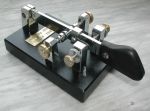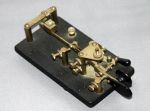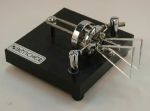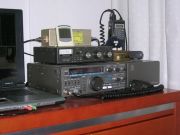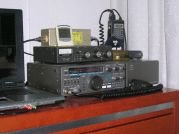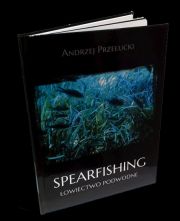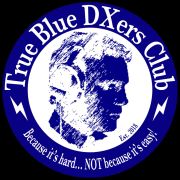Morse
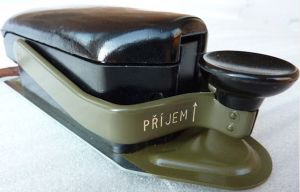






 by N1IRZ
by N1IRZCW Software
CW Freak
CWbliminal www.sintesinet.it
CW Player
Flex Morse
G4FON Morse Trainer
HFBT400
Just Learn Morse Code
Koch Morse Trainer
Morse Gen
Morse Runner
Morse Runner 1.67
Morse Test
Morse Tools
Morse-Trainer Offline
Pile Up Practice
Profm
QRP Sim
QRQ
RUFZXP
Teach Morse
The Straight Key is the simplest and most iconic. It's range of speed generally goes only into the low 20 wpm's, but more if you're fast. There's just a lever, a knob, some springs and some contacts. The sending method requires more arm than wrist action and may be quite fatiguing, but the sound produced by this key can be the most personal.
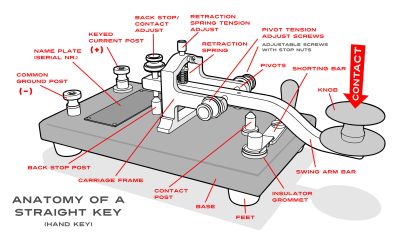
The Side-Swiper, otherwise called a "Sidewinder," "Cootie" or "Double-Speed" key was the next obvious evolution and employs a piece of spring steel mounted sideways with redundant contacts facing each side. When the handle is gripped and moves the arm left or right a contact will be made. There is a special method of sending whereas you always start each character's first element off with a movement to the left, alternating direction on each element. You can easily reach speeds up to the 30 wpm's and is much, much less fatiguing to use than a straight key as the arm can rest on the table. They are easy to build at home, requiring an old hacksaw blade and a few pieces of hardware. The sound of a side-swiper comes across with a "heavy" weighting.

The "Bug," otherwise known as a Semi-Automatic key is still a very popular option, going back to the early 1900's and can still be purchased new today from companies like Vibroplex with very little variation from early models. It's generally the most mechanically complex of most keys with a side-actuated swing arm held in place by spring returns. Moving the arm to the left causes a contact to be made which is exactly the same as a straight key, but turned to the side. Dashes are made with that actuation and can be used to send code as a straight key if desired. Moving the arm in the rightward direction causes a weighted pendulum, comprising the back portion of the swing arm, to vibrate or oscillate against a spring-loaded contact point, which produced "automatically" repeating dots. Moving the pendulum weight or changing it will likewise change the oscillation speed of the dots. Sending speeds, by default, sit in the 30 wpm's and many hams can send into the 50's! However, many hams enjoy slower beginner speeds by adding weight. The sound of this key comes across as having a potentially "light" weight with tell-tail dashes of seemingly longer duration.
The Dual-Lever Paddle, otherwise called a "Squeeze Key" or "Iambic" paddle and came about around WWII with the advent of more advanced electronic keying circuits. Each paddle needs only move a very minimal distance [even the thickness of a piece of paper] to make contact and for this reason is the least fatiguing and most comfortable to use. Sending speeds can also be at blinding rates, even into the 80's, but because the two contacts actuate electronic timing, new senders especially like paddles as they can send perfect 'PARIS' code as slow as they wish! Pressing the Left paddle with the thumb generally actuates automatic dots and pressing the Right paddle with the index finger will actuate the dashes. "Squeezing" and holding them both down at the same time actuates an "iambic" action whereas each elements will alternate, generally with the first element, either dot or dash happening first depending on which key was held first. Iambic keying is not hard to master
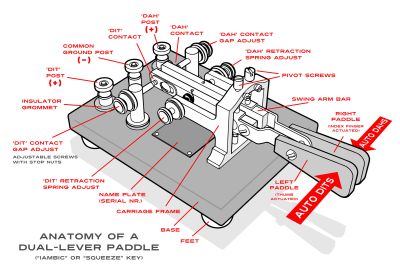
The Single-Lever Paddle is implemented with the same setup as the dual-lever paddle, with each opposing press of the paddle swing arm actuating their associated contact. The only difference is that there is not squeeze keying so iambic-like timing is up to the keyer circuit. Many prefer this variation as it is more forgiving and less error prone to send over that of the dual-paddle and for that reason some of the high-speed code sending champions of the world use this key to send code at "plaid and ludicrous" speeds into the 100's of wpm's! The sender can also wire each of the two contacts together and use as a variation on of the side-swiper

3.530 3.550 7.055 7.120 10.120 14.050 18.080 21.050 24.910 28.050 Mhz
-AM
29.000-29.200 MHz 3.870-3.885 Mhz
1.885 1.930 1.985 3.615 3.625 7.285 14.286 21.425 29.910 Mhz
-FM
29.600 FM Simplex
29.620-29.680 Mhz Repeater Outputs
-IOTA
3.530 3.755 7.055 10.115 14.040 14.260 18.098 18.128 21.040 21.260 24.920 24.950 28.040 28.560 Mhz
-QRP
3.560 3.690 7.030 7.090 10.106 10.116 14.060 14.285 18.096 21.060 21.285 24.910 24.950 28.060 28.360 Mhz
-PSK
3.580 7.035 10.140 14.070 18.110 21.070 24.920 28.120 Mhz
-DX
3.505 3.799 7.010 7.065 10.110 14.025 14.195 18.075 18.145 21.025 21.295 24.895 24.945 28.025 28.495 Mhz
-HF Pack
3.559CW 3.791USB 7.029,5CW 7.185USB 10.117,5CW 14.059CW 14.342,5USB 14,346USB 18.081CW 18.117,5USB 18.157,5USB 18.158CW 21.437,5USB 21.438CW 24.977,5USB 24.978CW 28.312,3USB 28.328CW Mhz
-Maritime Mobile
14.300 14.303 14.313 14.122.5 14.323 14.297 14.316 14.300 7.241 7.085 14.118 14.315 21.400Mhz
--10m FM repeaters
The standard 10-meter repeater offset is down 100 kHz.Some repeaters may require a CTCSS or PL tone.
29.510 - 29.590 Repeater inputs, (10 kHz spacing)
29.610 - 29.690 Repeater outputs, (10 kHz spacing)
>>>>> 10m FM repeaters list download Excel
10m Repeaters World Wide
Europe-10m-repeaters-list-25may2011
przemienniki.net



- 2 m repeaters Shift TX = RX - 600Khz
TX 145.0000 - 145,1875 Mhz
RX 145,6000 - 145,7875 Mhz
-70cm repeaters Shift TX = RX - 7.6Mhz
TX 431,0500 - 431,8875 Mhz
RX 438,6500 - 439,4875 Mhz
CTCSS freq in SP QTH LOC:
JO74 – H JO84 – S JO94 – J KO04 – B KO14 – F KO24
JO73 – F JO83 – Q JO93 – H KO03 – A KO13 – O KO23
JO72 – D JO82 – O JO92 – F KO02 – S KO12 – M KO22
JO71 – B JO81 – M JO91 – D KO01 – Q KO11 – A KO21
JO70 – A JO80 – J JO90 – B KO00 – O KO10 – D KO20 – H
JN79 JN89 JN99 – A KN09 – M KN19 – B KN29
A = 67,0 B = 71,9 D = 77,0 F = 82,5 H = 88,5 J = 94,8 M = 103,5 O = 110,9 Q = 118,8 S = 127,3Hz
--- Checking to see if the frequency is clear
QRL? or QRL? DE SP9HZX K
If the frequency is busy,we may hear a C,R or QRL.And we don't respond.
--- Calling CQ
CQ CQ CQ DE SP9HZX SP9HZX SP9HZX K
--- Receiving the response
SP9HZX DE 9H3BK AR
--- Responding
9H3BK DE SP9HZX GM ES TNX FER CALL = UR RST 599 599 HR QTH TYCHY TYCHY = NAME ANDY ANDY ES SKCC 8988 8988 SO HW CPY? 9H3BK DE SP9HZX KN
--- Continuing QSO, extra info
9H3BK DE SP9HZX FB DREW TKS FER RPRT ES INFO = WX HR WARM ES WINDY TEMP 27C = RIG IS KNWD TS430S ES ANT GP UP 20M = HW CPI? 9H3BK DE SP9HZX KN
Here we can either complete the QSO or engage in a longer QSO,called Ragchew
--- Completing the QSO
9H3BK DE SP9HZX TNX FER FB QSO DREW = HPE CU AGN = VY 73 TO U ES URS SK 9H3BK DE SP9HZX























 ZS6EZ
ZS6EZ 















